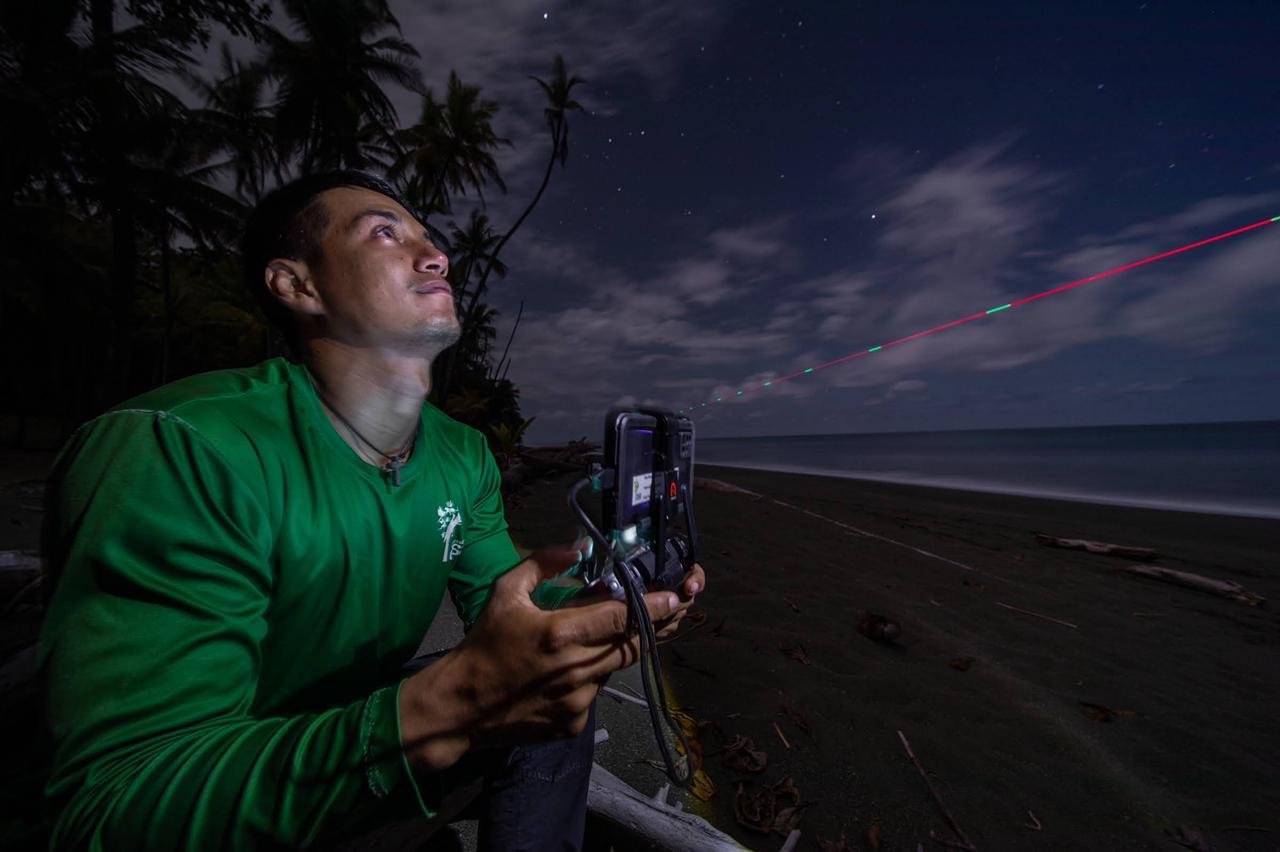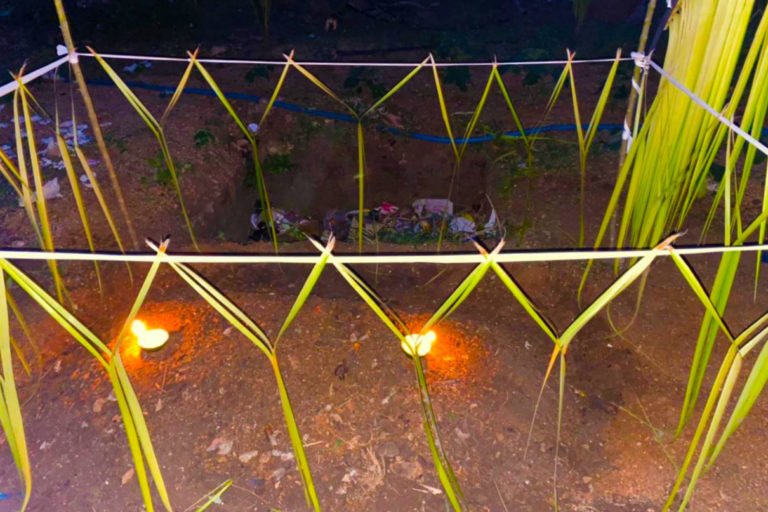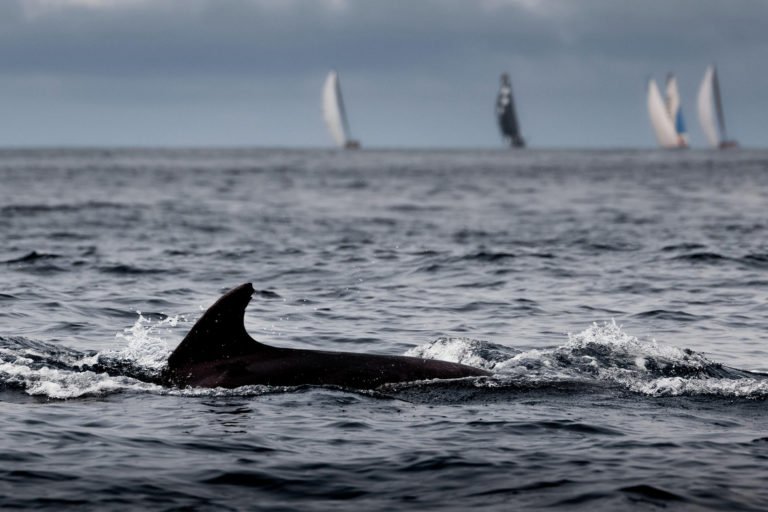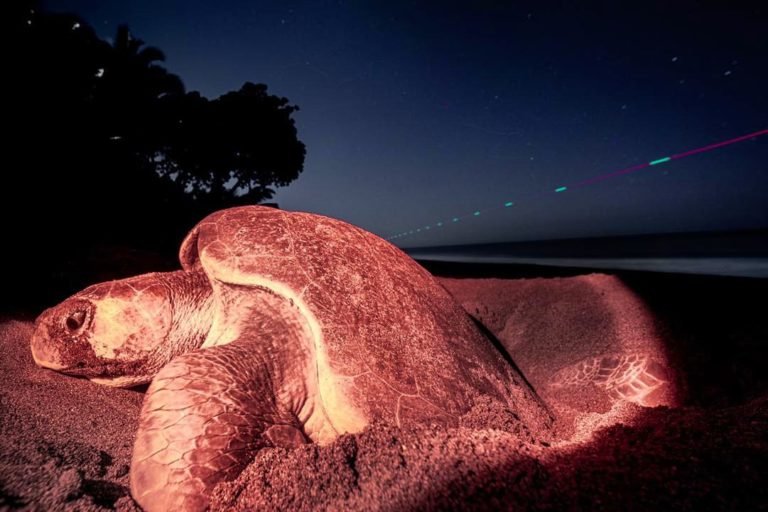- Researchers used heat-detecting cameras mounted on drones to monitor sea turtle nesting on a beach in Costa Rica’s Osa Peninsula.
- Using thermal infrared imagery, researchers detected 20% more turtle nesting activity than on-the-ground patrollers did. The drone imagery also revealed 39 nest predators and other animals, as well as three people, assumed to be poachers, that were not detected by patrollers.
- In Costa Rica, turtle eggs are sold locally and illegally for their alleged aphrodisiac properties. Six out of the seven species of sea turtles are threatened globally, and protecting their eggs is one of the easiest ways to ensure they endure into the future.
- The lead author says these methods are still rather expensive and aren’t a replacement for patrollers but could be an extra tool that they can use to get a big improvement on night patrols, especially on nesting beaches that are dangerous and inaccessible.
Sea turtles lumber from ocean to shore to lay their eggs in the sand. In some places, this effort is protected by humans who patrol beaches on foot, warding off poachers, predators and naïve tourists. But might there be a more effective way?
Researchers used thermal infrared sensors mounted on drones to monitor sea turtle nesting on a beach in Costa Rica’s Osa Peninsula. Using these heat-detecting cameras, scientists could not only see the turtles moving, but also see their tracks, differentiate the tracks of different species, detect hatchlings, and observe other wildlife and potential poachers.
This technology has been used before, but this is the first time these methods have been empirically tested for nighttime sea turtle monitoring. The results are published in the journal Frontiers in Conservation Science.
“Something that really surprised me was that the drone was able to detect tracks, because sometimes even for the patrollers is hard to differentiate them,” lead author Bárbara Sellés-Ríos, a researcher with the NGO Osa Conservation, told Mongabay in a phone call. And the fact they were able to get such clear images, she said, “was amazing.”

Sellés-Ríos and her team first took the drone out for test flights to find the best height and angle for the drone and mode for the camera to capture clear images while not disturbing the wildlife. At 50 meters (164 feet), they found, the drone sound was almost imperceptible over the sound of the ocean, and they didn’t notice any response from the turtles.
After optimizing the gear, the team set up an experiment to compare the detection of turtle activity by human patrols versus the drone images. For seven nights in October and November 2021, patrollers walked and drones flew multiple passes over a 1.7-kilometer (1.1-mile) section of beach, looking for turtles, eggs, tracks, and other signs of life.
Using thermal infrared imagery from the drone, researchers detected 20% more turtle nesting activity than the on-the-ground patrollers did. The drone imagery also revealed 39 nest predators and other animals, as well as three people, assumed to be poachers, that were not detected by patrollers.
“We could see on the screen that the patrollers were walking 30 meters [98 feet] away from the poachers hiding in the vegetation,” Sellés-Ríos said. Without the drone, they might have been missed.
Poaching remains a huge problem for sea turtles globally, especially in unprotected or unmonitored areas. In Costa Rica, many poached turtle eggs are sold locally and illegally for their alleged aphrodisiac properties.
Six out of the seven species of sea turtles are threatened globally, and protecting their eggs is one of the easiest ways to ensure they endure into the future.
“Sea turtles are slow to mature, and for some populations, it is estimated this may take up to or over 25 years,” Helen Pheasey, a lecturer in conservation science at the University of Kent, U.K., who has studied the sea turtle egg trade in Costa Rica, said in a 2020 interview with Mongabay. “This is significant, as it means the damage of removing eggs today will not be seen for 25 years when the offspring of the ‘poached generation’ fail to arrive at their nesting beaches.”

Poachers can pose risks for both turtles and human patrollers. Sea turtle conservationist Jairo Mora was killed by poachers in 2013 while patrolling Moín Beach on the Caribbean coast of Costa Rica. After his death, levels of egg poaching on the beach he protected expanded to nearly 100% of nests.
“The application [of the thermal imaging drones] for beaches that are dangerous to human patrollers is extremely attractive,” the study authors write, “especially if carried out with local enforcement authorities to help tackle illicit activities that impact threatened species, or along those beaches where it is challenging to gather data on populations because of the safety risk to patrollers (such as illicit narco activity), even if the turtles themselves are not necessarily at risk.”
“If you are a poacher and you see the drone flying above you,” Sellés-Ríos said, “you may think twice about poaching the nest, right?”
Sea turtle eggs are also targeted by natural predators. On the beach in Costa Rica where the study took place, 22% of all the nests were raided in the first 10 hours after eggs were laid, mostly by coatis and raccoons.

While this technology has promising implications for monitoring turtle populations and nesting activity and perhaps deterring poachers and predators, the authors do acknowledge several limitations. First, it’s expensive. The drone alone costs around $10,000, not to mention other equipment. Battery life is also a limiting factor, making larger areas more difficult to monitor.
Processing the images from the thermal infrared camera also takes a lot of time, and might not be feasible for underresourced conservation groups.
Sellés-Ríos says drones aren’t a replacement for patrollers but could be an extra tool that they can use to get a big improvement on night patrols, especially on nesting beaches that are dangerous and inaccessible.
“Although it’s in its infancy in turtle research, there is real potential here,” Pheasey said in an email to Mongabay about this study. “This is especially valuable as it is increasingly difficult to recruit volunteers to do the ground work. I can see drone research really taking off as techniques improve and costs come down.”
Banner image of nesting olive ridley sea turtle and the thermal drone flying in the back above the high tide line to monitor Pejeperro beach. Photo by Andy Whitworth/ Osa Conservation.
Citation:
Sellés-Ríos, B., Flatt, E., Ortiz-García, J., García-Colomé, J., Latour, O., & Whitworth, A. (2022). Warm beach, warmer turtles: Using drone-mounted thermal infrared sensors to monitor sea turtle nesting activity. Frontiers in Conservation Science, 3. doi:10.3389/fcosc.2022.954791
Liz Kimbrough is a staff writer for Mongabay. Find her on Twitter: @lizkimbrough_
FEEDBACK: Use this form to send a message to the author of this post. If you want to post a public comment, you can do that at the bottom of the page.











